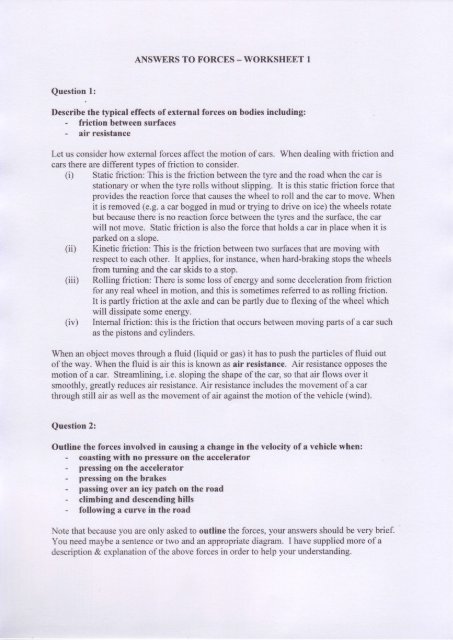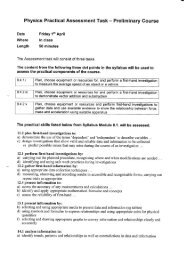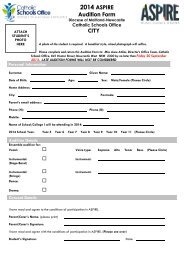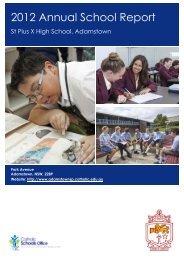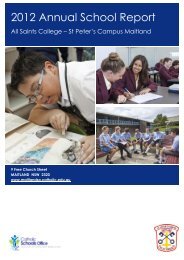Solutions to Force - Worksheet 1
Solutions to Force - Worksheet 1
Solutions to Force - Worksheet 1
You also want an ePaper? Increase the reach of your titles
YUMPU automatically turns print PDFs into web optimized ePapers that Google loves.
ANSWERS TO FORCES _ WORKSHEET 1<br />
Question L:<br />
Describe the typical effects of external forces on bodies including:<br />
- friction between surfaces<br />
- air resistance<br />
Let us consider how external forces affect the motion of cars. When dealing with friction and<br />
cars there are different types of friction <strong>to</strong> consider.<br />
(i) Static friction: This is the friction between the tyre and the road when the car is<br />
stationary or when the tyre rolls without slipping. It is this static friction force that<br />
provides the reaction force that causes the wheel <strong>to</strong> roll and the car <strong>to</strong> move. When<br />
it is removed (e.9. a car bogged in mud or trying <strong>to</strong> drive on ice) the wheels rotate<br />
but because there is no reaction force between the tyres and the surface, the car<br />
will not move. Static friction is also the force that holds a car in place when it is<br />
parked on a slope.<br />
(ii) Kinetic friction: This is the friction between two surfaces that are moving with<br />
respect <strong>to</strong> each other. It applies, for instance, when hard-braking s<strong>to</strong>ps the wheels<br />
from turning and the car skids <strong>to</strong> a s<strong>to</strong>p.<br />
(iiD Rolling friction: There is some loss of energy and some deceleration from friction<br />
for any real wheel in motion, and this is sometimes referred <strong>to</strong> as rolling friction.<br />
It is partly friction at the axle and can be partly due <strong>to</strong> flexing of the wheel which<br />
will dissipate some energy.<br />
(iv) Internal friction: this is the friction that occurs between moving parts of a car such<br />
as the pis<strong>to</strong>ns and cylinders.<br />
When an object moves through a fluid (liquid or gas) it has <strong>to</strong> push the particles of fluid out<br />
of the way. When the fluid is air this is known as air resistance. Air resistance opposes the<br />
motion of a car. Streamlining, i.e. sloping the shape of the car, so that air flows over it<br />
smoothly, greatly reduces air resistance. Air resistance includes the movement of a car<br />
through still air as well as the movement of air againstthe motion of the vehicle (wind).<br />
Question 2:<br />
Outline the forces involved in causing a change in the velocity of a vehicle when:<br />
- coasting with no pressure on the accelera<strong>to</strong>r<br />
- pressing on the accelera<strong>to</strong>r<br />
- pressing on the brakes<br />
- passing over an icy patch on the road<br />
- climbing and descending hills<br />
- following a curve in the road<br />
Note that because you are only asked <strong>to</strong> outline the forces, your answers should be very brief.<br />
You need maybe a sentence or two and an appropriate diagram. I have supplied more of a<br />
description & explanation of the above forces in order <strong>to</strong> help your understanding.
Inthe diagrams that follow:.Ep: force of engine,fe: air resistance,Jr: force due <strong>to</strong> friction,<br />
jr : force due <strong>to</strong> gravityJ. : centripetal force and y - velocity.<br />
(a) Coasting with no pressure on the accelera<strong>to</strong>r: When there is no pressure on the<br />
accelera<strong>to</strong>r there are no forward forces. If there were no backward forces then the car<br />
would keep moving forever at the same speed. However there is rolling friction, air<br />
resistance and friction between the moving parts of the car acting <strong>to</strong> oppose the<br />
motion of the car. Consequently the car will gradually slow down and s<strong>to</strong>p.<br />
v V<br />
/ 1r // / F /r //// /<br />
*J<br />
(b) Pressing on the accelera<strong>to</strong>r: Pressing on the accelera<strong>to</strong>r increases the rate at which<br />
fuel is fed <strong>to</strong> the cylinders of the car. This in turn increases the rate of rotation of the<br />
wheels and increases static friction. The reaction force <strong>to</strong> this increases the forward<br />
force on the car allowing it <strong>to</strong> overcome the forces that retard the motion. If the<br />
accelera<strong>to</strong>r is held in a position where it balances the forces opposing motion, the car<br />
will maintain constant speed. If the accelera<strong>to</strong>r is pressed a little harder the car will<br />
increase its speed.<br />
V<br />
v<br />
//r/ /1 /<br />
1r// / tt<br />
(c) Pressing on the brakes: The hydraulic system transfers pressure <strong>to</strong> the pads that grip<br />
the discs or drums. The pads exert a frictional force on the discs or drums that is in the<br />
opposite direction <strong>to</strong> the motion of the wheel. This slows the rate at which the wheels<br />
are rotating. This causes a forward force between the wheels and the road and the<br />
reaction force <strong>to</strong> this forward force causes the car <strong>to</strong> slow down and s<strong>to</strong>p. If <strong>to</strong>o much<br />
pressure is applied <strong>to</strong> the brakes they completely s<strong>to</strong>p the rotation of the wheels. This<br />
causes the wheels <strong>to</strong> slide (skid) over the road and since sliding (kinetic) friction is<br />
less than static friction the car travels a much greater distance before s<strong>to</strong>pping.<br />
--v -+<br />
/ /<br />
// // /<br />
n /r / / ///<br />
-d
(d) Passing over an icy patch on the road: Ice reduces friction <strong>to</strong> a very low value so<br />
pressing on the accelera<strong>to</strong>r would speed up the rate of rotation of the driving wheels<br />
but they would not be able <strong>to</strong> grip the road. The wheels would spin on the ice but the<br />
car would have no traction and would not increase its speed. The loss of friction<br />
would be disastrous for braking and steering. The brakes would s<strong>to</strong>p the wheels from<br />
rotating but according <strong>to</strong> New<strong>to</strong>n's first law) a car in motion continues in uniform<br />
motion unless acted on by a force. Hence the car would skid with liule change in<br />
speed until it was clear of the icy patch or until it met an opposing force such as the<br />
back of the car in front. Also because of the lack of friction, turning the wheels would<br />
not be able <strong>to</strong> produce a centripetal force. Consequently the driver would not be able<br />
<strong>to</strong> steer and the car would continue in a straight line even if the road didn't.<br />
//t /1/,/ / // ////<br />
Climbing and descending hills:<br />
All objects on Earth have a gravitational force on them pulling them <strong>to</strong>wards the centre of<br />
the Earth. This is true whether the object is on level ground or on a slope such as a hill. A<br />
car on a hill has a gravitational force acting vertically down. This applies whether the car<br />
is climbing (ascending), descending or parked on the hill. The gravitational force mg, can<br />
be divided in<strong>to</strong> components perpendicular <strong>to</strong> the plane and parallel <strong>to</strong> the plane. The<br />
parallel component applies a force of mg sinO downhill.<br />
(e) Climbing a hill:<br />
The parallel component applies a force mg sinO downhill.<br />
f,<br />
lg
When a car is climbing a hill the driver has <strong>to</strong> press harder on the accelera<strong>to</strong>r <strong>to</strong><br />
overcome the gravitational force downhill.<br />
(f) Descending a hill:<br />
f,<br />
When the car is descending the hill the driver does not have <strong>to</strong> press the accelera<strong>to</strong>r as<br />
hard since some of the downhill force is supplied by gravity. On steep hills the engine<br />
may have <strong>to</strong> supply no force at all and the car will coast down the hill. In these cases<br />
the car has <strong>to</strong> be slowed by the brakes. The problem is that constant hard braking can<br />
cause the brakes <strong>to</strong> overheat and become less effective. An alternative <strong>to</strong> constant<br />
braking is <strong>to</strong> choose a lower gear <strong>to</strong> descend the hill (eg"Steep Descent - Trucks Use<br />
Low Gear" signs on the road). Using a lower gear ensures that the wheels turn more<br />
slowly and are subject <strong>to</strong> less static friction.<br />
(g) Following a curve in the road: A body will travel with uniform velocity unless acted<br />
on by a force (New<strong>to</strong>n's first law). Therefore a force is required <strong>to</strong> change the<br />
direction of a car. When following a curve in the road, the necessary force is a<br />
"centripetal force". This force always acts <strong>to</strong>wards the centre of the motion i.e.<br />
<strong>to</strong>wards the centre of the road's curve. The force is supplied by the friction between<br />
the tyres and the road and has a value of: F, : mu'lr,where Fr: centripetal force, m:<br />
mass of car" v : linear velocitv of car. r : radius of curve.<br />
E '' C"*lrn of cur,re<br />
The centripetal force is always <strong>to</strong>wards the centre.
Question 3:<br />
Interpret New<strong>to</strong>nos Second Law of Motion and relate it <strong>to</strong> the equation XF = ma<br />
New<strong>to</strong>n's second law states that the net force on an object is equal <strong>to</strong> the product of its mass<br />
and its acceleration and that the acceleration is in the direction of the force.<br />
Thus, if a force of a given size is applied <strong>to</strong> several different masses we will find that the<br />
larger the mass the smaller the acceleration of the object.<br />
The term "net force" refers <strong>to</strong> the sum of all the forces acting on the object. Hence the<br />
X (capital sigma) in front of the F in the formula. E stands for "the summation of'.<br />
Examples: (i) At the school athletics carnival, athletes prefer <strong>to</strong> use a light shot put rather<br />
than a heavy one because they are able <strong>to</strong> give the light shot put a larger acceleration. This<br />
means that it will attain a larger velocity as it leaves the hand and so travel further before it<br />
hits the ground. (ii) In cars, if the same engine is installed in a heavy and a light car, the light<br />
car will attain the higher acceleration for the same applied force from the engine.<br />
Question 4:<br />
Identify the net force in a wide variety of situations involving modes of transport and<br />
explain the consequences of the application of that net force in terms of New<strong>to</strong>nts<br />
Second Law of Motion<br />
Note the words "identifytt and "explain"<br />
Consider the forces acting in planes, trains and cars.<br />
Planes: The physics of flight is extremely complex. Let us consider a plane just at take-off.<br />
There are two components of the net force that we have <strong>to</strong> consider. First there are the<br />
horizontal components of the motion that provide the planes forward motion and secondly<br />
there are the vertical forces acting that cause the plane <strong>to</strong> lift from the ground.<br />
The vertical motion of the plane is caused by dynamic lift (as opposed <strong>to</strong> static lift such as a<br />
balloon where the object rises in a more dense fluid). The dynamic lift of an aircraft is caused<br />
by two fac<strong>to</strong>rs, both of which rely on the plane moving forward through the air.<br />
The first is caused by the wing sloping upward <strong>to</strong>wards the direction of forward motion so<br />
that the air is deflected down. The second is due <strong>to</strong> the shape of the wing. The wing is curved
so that air travelling over the <strong>to</strong>p of the wing travels a greater distance than air travelling<br />
underneath the bot<strong>to</strong>m of the wing. This results in the air travelling over the <strong>to</strong>p occupying a<br />
greater volume in the same time and so being less dense. While the difference in density<br />
would create very little lift for a stationary object, there is substantialift for a moving object.<br />
This is due <strong>to</strong> the Bernoulli principle that is beyond the scope of the current HSC physics<br />
course. It used <strong>to</strong> be done in a Fluid Dynamics Half Elective some years ago.<br />
The forward thrust of a jet plane is caused by the reaction force <strong>to</strong> the exhaust gases<br />
(New<strong>to</strong>n's third law). A bigger engine or more engines gives a greater forward force. There is<br />
also the force of air resistance opposing the motion of the airqaft. The net force is forward<br />
and the acceleration is given by a: Fn.1 /m.<br />
Note that as a plane takes off, the net force acting on the plane at any point in time is the sum<br />
of the vertical &horizontal forces acting on the plane atthatpoint in time. This would<br />
require a vec<strong>to</strong>r diagram <strong>to</strong> determine the net force on the plane at any point in time.<br />
Trains: There are several different types (steam, diesel, electric) but all rely on the principle<br />
of a force causing the wheels <strong>to</strong> turn and the static friction between the wheels and the rail<br />
providing the forward (reaction) force <strong>to</strong> cause the train <strong>to</strong> move. There is friction between<br />
the moving parts of the train as well as air resistance but the overall result is a net force<br />
forward which results in the forward acceleration of the train. The train will attain a constant<br />
velocity when the forward force is equal <strong>to</strong> the sum of the backward forces.<br />
Cars: These experience much the same forces as trains except that there is friction between<br />
the tyres and the road rather than between the wheels and rail. Tyres have atread pattern, so<br />
the friction between the tyres and the road is usually greater than the corresponding friction<br />
between train wheels and the rails. There is friction between the moving parts of the car as<br />
well as air resistance but the overall result is a net force forward which results in the forward<br />
acceleration of the car. The car will attain a constant velocitv when the forward force is equal<br />
<strong>to</strong> the sum of the backward forces.<br />
A Note on Friction for the Teacher<br />
Two types of friction can occur between a car tyre and the ground, a) static friction, and b)<br />
kinetic friction.<br />
Static friction is when the tyre maintains grip or traction on the road surface, whereas kinetic<br />
friction (as the name implies) is when the tyre is moving relative <strong>to</strong> the ground. To illustrate<br />
static friction, consider for a moment a dot on the tyre's surface. Your vehicle is moving<br />
forward (let's say it's moving very slowly), and your tyre rotates so that the dot comes in<strong>to</strong><br />
contact with the ground at a certain point. Since a car tyre compresses a bit on the road's<br />
surface, there's approximately lOcm of tyre flat againsthe road at any given time. As your<br />
car moves forward, the tyre rotates, and once the dot <strong>to</strong>uches the ground at a given point, the<br />
tyre and the ground move at the same rate relative <strong>to</strong> the car. That is, the dot on the tyre and<br />
the point on the ground remain in contact until the tyre reaches the end of that 10cm strip of<br />
contact, when it is pulled upward from the ground <strong>to</strong> rotate around <strong>to</strong>p and back <strong>to</strong> the<br />
ground.
An example of kinetic friction from the illustration above would be that the dot on the tyre<br />
reaches a point on the ground, but the dot and point move away from one another. In real life<br />
this would be if you hit the brakes and skid, or if you hit the accelera<strong>to</strong>r and burn out or spin<br />
your tires (e.g. in the snow or mud). The problem with kinetic friction is that it is weaker than<br />
static friction. Thus, when you hit the brakes, if your tyres lock up (you will hear the<br />
squealing tyres against the road) you are now in kinetic friction and your car will slow down<br />
less quickly compared <strong>to</strong> when your tyres were in static friction with the ground. That is why<br />
you pump your brakes... also why anti-lock braking systems (ABS) were developed.<br />
Read more: http://wiki.answers.com/Q/Flow_does_friction act on_a_car#ixzzl yl iQAOKu<br />
Question 5:<br />
The mass of an object is a measure of the amount of matter contained in the object. Mass is a<br />
scalar quantity. The weight of an object is the force due <strong>to</strong> gravity acting on the object.<br />
Weightis avec<strong>to</strong>rquantity. W-mg, where W-weightforce, m:masS, g: acceleration<br />
due <strong>to</strong> gravity.<br />
.r-"i***,<br />
$gF'ii.<br />
'
J<br />
i<br />
/<br />
.l!,. -.--.<br />
a -..-<br />
l-<br />
F<br />
t<br />
e<br />
_Ml<br />
4<br />
+ f-<br />
f-v7<br />
: {-f<br />
T<br />
iL a"s-L/ U*#<br />
rvt -- z4ao k<br />
V = 2r*'.<br />
.(/ -5-<br />
+<br />
=Q nfl<br />
a- q'<br />
k<br />
=<br />
O- Z.f<br />
/a<br />
= -Z'fr+g-L<br />
b.q- ad C+<br />
/'f<br />
_<br />
.1..',1, :,h-r.- k = ZLo-o y -2-{<br />
= -{;fe-,O_<br />
U
g. 4s*onn't" er/o*e*.R- A:fi- s-r4*"s /^n'+s /*,,r"1.<br />
/k,o 4"* lr"i*'*zlt,'-,ii*,r* /,a &.f *<br />
oko.<br />
-/(u. c.;rk,^ rK-"/"/,,<br />
ar- A"t"l 4'rm( o1 ,A-s"-f(<br />
fl- a-s*rr*','/t' /A""s<br />
flouetnq, .f- //"""tr;n Atr<br />
Qr
J ..,,<br />
c<br />
Q*, Ar k uoviu< a{ a.<br />
,d<br />
e*rt"tN{<br />
Zo,u/s&r&<br />
/,--<br />
(<br />
''.. ia.ft<br />
t/t r ,/r<br />
(d/ f; = ({ao{r<br />
ne#L<br />
Cr-tr<br />
_ffg* F-w\A- | O\=;<br />
I<br />
I<br />
-6, 4ae/e1afi'o-r- o/ af<br />
Y- ^., AV V"-A<br />
b.q ru, = l.zoo.L6 _,<br />
V = 72k^I .'=c<br />
f-fc'r*rr,,-4=aG=-ftn-<br />
s;t- (A4 A.f,<br />
tf<br />
bf o_ lvttaa<br />
.a<br />
:s.5 =<br />
= f 3ils-: rp"&--<br />
.,<br />
: - f,g A{.-2 Af!-currv teurk t *v+.<br />
)o<br />
o-b<br />
^r
'rn'.u<br />
T<br />
= 3-3,<br />
q /L *J ,+ I* Aoo {q et ,+^ve/.r h,L t,<br />
J.'7fr i/ /ukos A tA,u /""-^ f srfu t*-<br />
,t'* fisz/ ,+ a// # fLr &'/*",h<br />
A|'t{,*vn rt4a,rerl 4<br />


